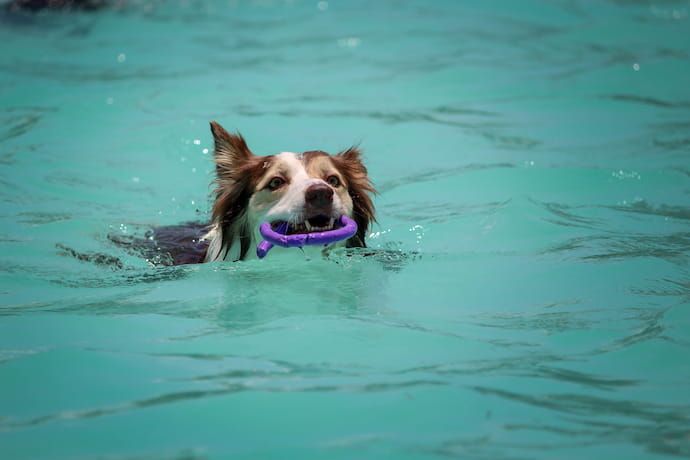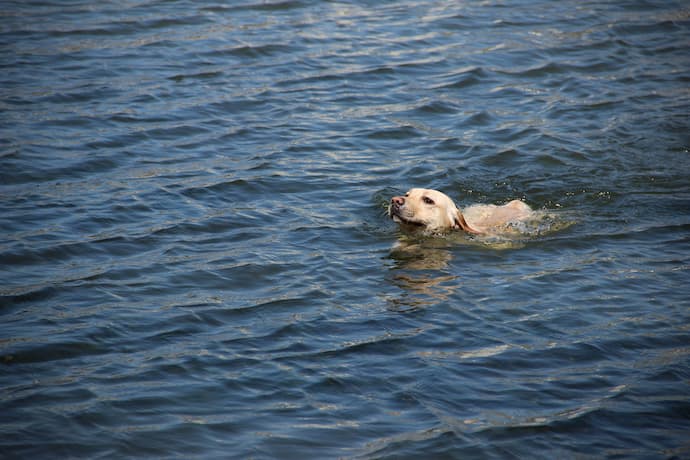There's a common notion that dogs are natural swimmers. In fact, you've probably seen it portrayed in family-themed movies where you see a dog swimming excitedly. A scene would show how they run towards a body of water without hesitation and happily swim with their fur parents and friends. Yes, there are indeed dogs that do well and enjoy swimming in the water.
Some would even run excitedly and jump in every body of water that they encounter. However, this is not always the case. Some find swimming challenging, and some even avoid water altogether. And while it might come naturally for dogs to dog paddle when they are submerged in water, it doesn't always mean that they can easily float, swim safely, or have fun in the water.

Your dog might love to plunge in the water, or they may look the other way. A research study, for instance, points out that swimming for canines has great potential as both a therapeutic tool and a way to keep your pooch fit.
Nevertheless, you might have asked: Can all dogs swim? Are dogs natural swimmers? The truth is, some dog breeds struggle in the water no matter how hard they try to paddle. In any case, there are safety tips and dog swimming skills that can be taught to help your dog be more comfortable in the water if they aren't.
Dog breeds that can't swim
A dog's breed is often a factor when we talk of which dogs love the water and which ones struggle with it. In reality, certain breeds are born swimmers. Some of these breeds are the Nova Scotia Duck Tolling Retriever, the Standard Poodle, the Labrador Retriever, the Irish Water Spaniel, the Portuguese Water Dog, and the Otterhound. Physically, they have features that allow them to swim with ease.
On the other hand, some dogs can't swim. These dog breeds are often those with unequal weight distribution and/or with short muzzles. Let us look at some of these dog breeds and why they struggle with swimming.
- Bulldogs
Unfortunately, because of their flat faces, large chests, and chonky bodies that are disproportionate to their short hindquarters, bulldogs' bodies aren't designed for swimming. Even one of these features makes it difficult for dogs to swim, and for a bulldog who has all these features combined, it makes it even harder. Because of this, the Bulldog is the #1 dog breed that finds it most challenging to swim. This goes for both French bulldogs and English bulldogs.
- Basset Hounds
Basset hounds have big heads and short legs, making it hard for them to float on water. Not to mention, they are prone to ear infections whenever water enters their ear canal due to their long, floppy ears.
- Dachshunds
Since Dachshunds have long bodies coupled with short legs, swimming proves difficult for them. In fact, even if the water is shallow, dachshunds may get too tired of paddling. It is therefore essential to keep them in sight whenever there's water around.
- Corgis
Though both Pembroke Welsh corgis and Cardigan Welsh corgis like to be around water, they're not really good swimmers. This is because corgis have thick chests, long bodies, and very short legs like that of the dachshunds. Does this mean that you shouldn't let your corgi near any body of water? Not necessarily. Since they love water, you can let your corgi enjoy it but make sure that the water is shallow.
- Bull Terriers
Terrier breeds are active dogs, and this applies to bull terriers. However, despite being active, a bull terrier's large chest and short legs make it challenging for them to float on water. They also have disproportionately large heads and big muscles, making it hard for them to swim.
- Shih Tzu
Aside from their small size, other physical features of Shih Tzus, such as their short muzzles and legs, make it difficult for them to swim. And since they usually have a full coat, this can wear them down and cover their faces, making it harder to breathe. Not to mention, they have a tendency to feel cold easily when they're in the water for long periods. And even though swimming might not be a comparative advantage, Shih Tzu is an excellent breed for first-time dog owners because of how affectionate these dogs are.
- Pugs
You might find that pugs don't shy away from shallow water. In fact, they may even enjoy it. However, their flat faces coupled with excitement may lead to difficulties breathing when the water is deeper. At the same time, being a brachycephalic breed, pugs need to exert more effort in keeping their heads above the water because their back ends sink lower while doing so.
How to teach your dog to swim
- Starting with a dog life jacket
A good headstart in dog swimming lessons is to get your dog a comfortably-fitting dog life vest or floatation device. The first time that your dog steps in the water, you want them to remember it as a positive experience rather than a stressful or terrifying one.
Therefore, it isn't a good idea to throw a newbie into the water and expect them to figure things out by themselves because this can lead them to fear water even as they grow older. Remember that some dogs may seem confident as they run towards the water or chase after another dog, but get surprised and panic once they realize that they're in the water for the first time.
Developing your dog's courage to be in the water is key, and a great way to do this is by letting them use a life vest to build their confidence first as they paddle with the help of a flotation device. A first-time dog swimmer without a life vest might only paddle with their two front feet, with their hind legs trying to reach for the ground. With a life vest, however, your dog can comfortably float then it can help them realize that they can use all their four feet to paddle. Soon enough, they'll be able to confidently move in the water.
- Guide and support your dog
While your dog is in a life vest, use toys or balls to encourage them to swim while supporting the flotation device. When they're having fun as they begin to swim, they'll be able to gain more confidence. If you feel they start to sink, provide support by lifting their belly section, so they can float more properly.
Make sure that you're just nearby as they start swimming to prevent them from panicking. For deeper water levels, make sure that you also have a life vest with you, as your dog can climb on you from time to time in the process of learning.
- Invite a furry friend who knows how to swim already
Having a furry friend around who can already swim confidently is a good way for your dog to learn the ropes (with a life vest at first) as they get to observe how their friend does it while having fun as they play in the water together. This way, your dog also realizes how enjoyable being in the water can be.
If your dog really doesn't like to swim despite your efforts, that's alright. There are many activities that your dog can enjoy on the seashore. You can swim while your dog plays on the beach, and you can play together as you pause from swimming. Just keep an eye on your pup all throughout your day out.
Safety Tips

-
It's recommended to start in shallow water first and allow your dog to be accustomed to the feeling of having their feet wet. Stay in shallow water until your dog feels comfortable and at ease already. After which, you can gradually bring your dog into deeper water levels while using positive reinforcement and rewards along the way. When your dog may seem anxious, you can go back to shallow waters or on the ground to calm your dog down at first before going in the water again.
-
While you may be having so much fun, it's not advised to let your dog swim for long periods to prevent them from getting tired. However, you can take breaks and come back if your pooch still has the energy and enthusiasm.
-
Among the other precautions is to make sure that the temperature is not too cold, with the combination of both air and water temperature not going below 100 degrees Fahrenheit. This is because of the risk of your dog getting a cold tail or swimmer's tail, a condition where the tail cowers down without wagging or going up. Apart from this, cold temperatures may also lead to your dog experiencing hypothermia, which can be life-threatening.
-
Make sure that your dog doesn’t ingest large amounts of water, especially salt-water as this may cause water intoxication or hyponatremia.
-
Be on the lookout for hazards as well, such as other creatures in the water, to prevent your dog and yourself from being in harm's way. Close supervision is essential.
-
Another thing to note is that dogs may be prone to sunburn, too, just like humans, especially on a hot summer day. Providing them with the right sunscreen, especially in their ears and nose, helps protect them from the UV rays while preventing a bad sunburn. To prevent dehydration, make sure to also give them fresh water before and after swimming or in between dips.
Was this article helpful?
Help us make our articles even better









